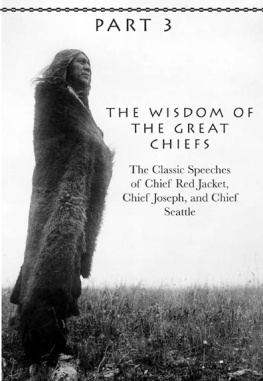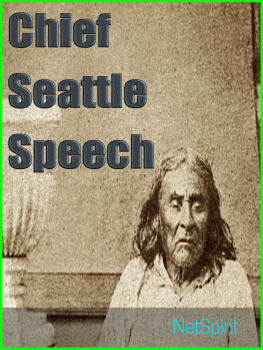THE WORLD OF
CHIEF SEATTLE

THE WORLD OF
CHIEF SEATTLE
How Can One Sell the Air?
Warren Jefferson

2001 Warren Jefferson
Cover and interior design: Warren Jefferson
Published in the United States by:
Native Voices, an imprint of Book Publishing Co.
P.O. Box 99
Summertown, TN 38483
888-260-8458
http://www.bookpubco.com
12 11 10 09 08 3 4 5 6 7 8
Printed in Canada
All rights reserved. No portion of this book may be reproduced by any means whatsoever, except for brief quotations in reviews, without permission from the publisher.
Photographs from the Suquamish Tribal Archives and excerpts from the Suquamish Tribal Oral History Project are used with permission of the Suquamish Tribe. Copyright the Suquamish Museum
ISBN13: 978-1-57067-095-4 ISBN10: 1-57067-095-1
Cover photo: Evening on Puget Sound, by E.S. Curtis, c. 1899. Special collections, University of Washington library, #080. STA 1106.
Jefferson, Warren, 1943
The world of Chief Seattle: how can one sell the air? / Warren Jefferson
p. cm.
Includes bibliographical references
ISBN 1-57067-095-1 (pbk. : alk. paper)
1. Suquamish Indians--History. 2. Suquamish Indians--Social life and customs. 3. Seattle, Chief, 1790-1866--Oratory. 4. Speeches, addresses, etc., Suquamish. I. Title.
E99.S85 J43 2001
979.7004979--dc21
00-062463
When the sea is out, the table is set. Puget Salish saying

TABLE OF CONTENTS
PHOTOGRAPHS
STA-Suquamish Tribal Archives
. |
. |
. |
. |
. |
. |
. |
. |
. |
. |
. |
. |
. |
. |
. |
. |
. |
. |
. |
. |
. |
. |
. |
. |
. |
. |
. |
. |
. |
. |
. |
. |
. |
. |
. |
. |
. |
. |
. |
. |
. |
. |
. |
. |
. |
. |
. |
. |
. |
. |
. |
. |
. |
ILLUSTRATIONS
The following illustrations are by the author.
The following illustrations are by other artists.
THE ILLUSTRATIONS IN THIS BOOK, EXCEPT MOSQUITO MASK DANCER PAGE 111, ARE AVAILABLE FOR PURCHASE BY CONTACTING THE PUBLISHER:
BOOK PUBLISHING CO.
P. O. BOX 99
SUMMERTOWN, TN 38483
931-964-3571
PREFACE
Lawrence Webster was a retired logger, like thousands of men in northwest Washington. However, Webb, as he was known, was a member of a small and special group. He was an Elder of the Suquamish Tribe and a speaker of the Puget Sound Salish language. Born in 1899, Webb was a former Tribal Chairman and lived in Indianola, near where he was raised. The sidebar quotes from him and other Suquamish Elders are taken from interviews given on the Port Madison Indian Reservation as part of the Suquamish Tribal Oral History Project.
Marilyn Jones is Director of the Suquamish Museum and an Oral Historian for the Suquamish Tribe. She was born and raised on the Port Madison Indian Reservation, and as a young girl began a lifelong quest to learn about the traditional ways of her tribe. At age seven she would lead tours of area students through the reservation, showing them important sites of her people and telling them stories she heard from the Elders about the old days. She was eventually hired as an Oral Historian for the Suquamish Tribal Cultural Centers Oral History Project. The sidebar quotes from her are taken from an informal interview by the author on the Port Madison Indian Reservation on April 22, 1999.
I want to give a special thanks to Marilyn Jones for making available to me Suquamish Tribal archives and for her help in editing this book for accuracy according to Suquamish Tribal history.
Warren Jefferson
INTRODUCTION

This is the story of Chief Seattle and his tribe, the Suquamish. They live on Kitsap Peninsula on the shores of Puget Sound across from Seattle, Washington, in an area known as the Pacific Northwest region of the United States. The Suquamish have lived in this region for thousands of years.
Chief Seattle is renowned for a powerful and eloquent speech he gave in 1854 during treaty negotiations with agents of the United States government. In his speech, Chief Seattle expressed a commitment to living in peace with the settlers and their new culture, and he asked, in turn, that the settlers respect his people and the natural world that they shared. Today his words live on and have inspired many in the human rights and environmental movements around the world.
... the very dust under your feet responds more lovingly to our footsteps than to yours, because it is the ashes of our ancestors, and our bare feet are conscious of the sympathetic touch, for the soil is rich with the life of our kindred.
Chief Seattle
Prior to contact with white settlers, the Suquamish were a powerful tribe in control of a large area of northern Puget Sound. Their chiefs were very influential and had extensive alliances with other tribes throughout the region. As a young man, Chief Seattle distinguished himself as an effective military leader and strategist by stopping raids by aggressive tribes from the north. Because of his military successes and great oratory ability, he became chief of both the Suquamish and the Duwamish tribes.
My ancestors had built seventeen longhouses located through out their area of control.
Marilyn Jones
Chief Seattle was a young boy when European explorers first sailed into Puget Sound in 1792, nearly 300 years after Columbus discovered America. During the next seventy-three years, in the course of one mans lifetime, the tribes of Puget Sound went from enjoying a culturally rich, autonomous lifestyle to almost total decimation by the non-Native society.
Next page









